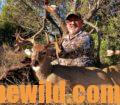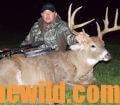This monstrous buck showed up on November 19, 2016, deer season’s opening morning and was the first time Heath Kersten of Denmark, Wisconsin, ever had seen him. Hunting on his father-in-law’s land on a fence line dividing that property and a neighbor’s, Kirsten also had that neighbor’s permission to hunt his land. “Opening day had rain, snow and 40 mph winds, so I knew sitting in my stand would be tough,” Kersten says.
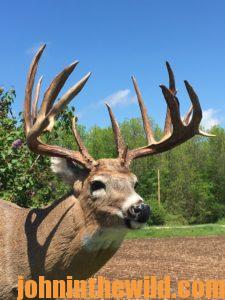 At a sporting-goods store the summer before the 2016 deer season arrived, Kersten bought a plastic ground blind that had been drastically reduced in price, due to the box’s damage. But when Kersten opened the box, he saw the plastic blind wasn’t damaged at all. He had all summer to build a 6-foot-high platform for the blind – a family project with his father-in-law and his children. He set the platform up between two trees on the edge of a hill, overlooking a plateau that had deer trails on both sides and a fence line on one side.
At a sporting-goods store the summer before the 2016 deer season arrived, Kersten bought a plastic ground blind that had been drastically reduced in price, due to the box’s damage. But when Kersten opened the box, he saw the plastic blind wasn’t damaged at all. He had all summer to build a 6-foot-high platform for the blind – a family project with his father-in-law and his children. He set the platform up between two trees on the edge of a hill, overlooking a plateau that had deer trails on both sides and a fence line on one side.
“Early on opening morning of 2016, when I got into my car to go to my stand, the pouring rain soon turned to snow,” Kersten remembers. “What should have been a 20-minute ride to the property I planned to hunt became a more-than 30-minute drive due to the snow. Because of the high winds, I was hoping my tree stand still would be on top of the platform we’d built when I reached it.”
The ground was too warm for the snow to stick, but the snow coming down hard quickly piled up. When Kersten reached his stand, he lit the heater. During the first hour of daylight, Kersten spotted a big buck going across the fence line, coming up to the plateau, jumping the fence and going out into the field about 150 yards from him. “Even in that early light, I could tell he was the biggest buck I’d ever seen,” Kersten says.
That big buck trotted off the field and went over behind the mountain, later returning and becoming silhouetted. Since Kersten wasn’t certain where his bullet would go or how far, if he shot through the buck or missed him completely, he chose not to take the shot. As the buck moved down the mountain toward Kersten, he had another chance to take a shot. “When the buck came down off the hill and had ground behind him, I felt I then could take a shot,” Kersten explains. “But I spotted lights in my scope about 200-yards behind the buck in a neighbor’s house. So, I turned down the shot and let the buck continue to come down the trail.”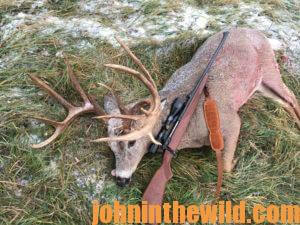
Once the buck passed the house, to get the shot, Kersten had to move from one of the windows in his shooting house to another. When he had his rifle out the window and on the buck, he watched the buck running fast and then slowing down to a walk. Kersten couldn’t time his shot with the deer moving. As the buck kept coming toward Kersten, Kersten noticed that the buck was about to walk in front of a hunting camp where there were lights. Once more Kersten didn’t shoot, not wanting to endanger anyone who still might be in the camp. After clearing the hunting camp, the buck hit his emergency brake, stopped dead still and whipped his head around in the direction of Kersten’s blind.
“That’s when I remembered I’d put some doe-in-estrus deer lure out on that side of my blind, and I felt certain the smell of that estrous urine was what made the buck stop and look in my direction,” Kersten explains. “Looking through my Simmons http://www.simmonsoptics.com/riflescopes/index.aspx 2.8-10x rifle scope, I immediately squeezed the trigger on my Savage https://www.savagearms.com/ .270. I watched the buck about 90 yards away kick and buck when he took the bullet, before trotting about 40 yards, finally slowing down and then tipping over at the edge of the field.”
Quickly Kersten cranked another shell into his rifle’s chamber and once again studied the buck to make sure he stayed down. Kersten no more had gotten his scope on the buck when his cell phone 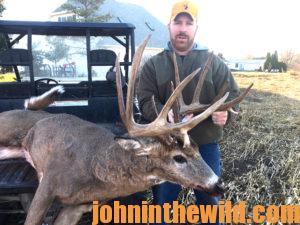 vibrated. His brother-in-law Bill Schuh, who was hunting 300 yards away, texted, “Did you get him?” Kersten texted back, “How do you know it’s a him?”
vibrated. His brother-in-law Bill Schuh, who was hunting 300 yards away, texted, “Did you get him?” Kersten texted back, “How do you know it’s a him?”
Kersten’s friends knew he primarily hunted for meat and gladly would shoot a big doe. The buck was on the ground, the wind had picked up speed, and Kersten’s blind was rattling, squeaking and moving. Kersten was attempting to hold his phone while texting, looking at the buck with his rifle scope, holding his gun steady and watching the buck’s ear that appeared to be twitching.
“I couldn’t tell for sure whether the buck was still alive, or if the wind was blowing so hard that it was causing the buck’s ear to move,” Kersten recalls. “I thought about shooting the buck again.” When Kersten looked back at his phone, he saw that Bill had asked, “Do you need any help?” “I texted Bill back and told him I didn’t know because I hadn’t gotten down from my stand yet.”
After 10 minutes, Kersten came out of his stand, walked over to his buck and looked in disbelief at his immense size. “I didn’t know what to think,” Kersten recalls. “The antlers didn’t just have round antlers like you see on most bucks, but instead had some antlers that were flat and bladed. The main beams had webbing. My buck was so big I felt it had to weigh 150 or more pounds live weight. I hoped he might score 170 inches. Of course, I’d never scored a buck before, so I didn’t know what to think. “Bill’s son Eric, who was hunting with Bill, had a 4 wheel drive truck. He drove through the thick, piled up snow and helped me load up the buck. Eric was as dumbfounded as I was when I saw the buck. We only got a few pictures of the deer in the field, since the cell phone froze up due to the cold weather. He scored 206-2/8 inches.”
To learn more about hunting deer, check out John E. Phillips’ book, available in Kindle, print versions and Audible, “Whitetail Deer and the Hunters Who Take 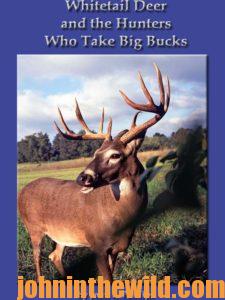 Big Bucks,” (http://amzn.to/2bYwYOK). You may have to copy and paste this link into your browser. (When you click on this book, notice on the left where Amazon says you can read 10% of this book for free).
Big Bucks,” (http://amzn.to/2bYwYOK). You may have to copy and paste this link into your browser. (When you click on this book, notice on the left where Amazon says you can read 10% of this book for free).

